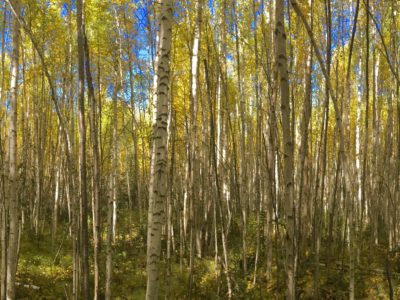
Severe Fires Drive Shifts from Black Spruce to Broadleaf Dominance
Severe Fires Drive Shifts from Black Spruce to Broadleaf Dominance
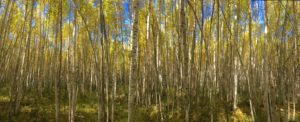
A recent shift in the Alaska fire regime has increased the frequency and size of high-severity fires that combust deep organic layers, exposing mineral soil and favoring the invasion of hardwoods. Within the BNZ LTER Regional Site Network, many sites that were dominated by black spruce prior to burning in 2004 have now converted to dense birch stands with very different vegetation and ecosystem characteristics (BD1 site).
Credit: Roger Ruess
Severe late summer fires consume the soil organic layer, allowing deciduous tree species, such as aspen and birch, to establish at high densities. The fast decomposing litter and rapid evapotranspiration of deciduous trees maintain a thinner, drier organic layer that does not sustain spruce forests or insulate permafrost. This ecosystem state change alters an iconic Alaskan ecosystem by modifying productivity and carbon storage, climate regulation, and other ecosystem services to society.
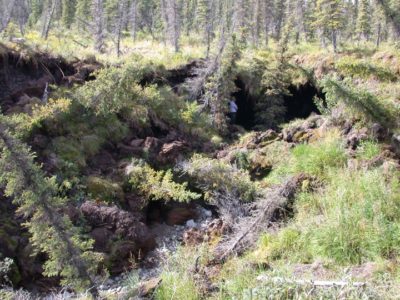
Thawing Permafrost and Increasing Wildfires Will Likely Amplify Climate Warming
Thawing Permafrost and Increasing Wildfires Will Likely Amplify Climate Warming
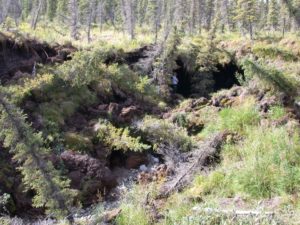
Increases in air temperatures and depth of insulating snow cover during winter are accelerating the rate of permafrost thaw. In areas of ice-rich permafrost, widespread thermokarst is having significant consequences for biogeochemical cycling and surface hydrology.
Credit: Ted Schuur
Measurements across latitudinal gradients, field experiments, and laboratory incubations all point to significant releases of CO2 and CH4 from soils that have been frozen or waterlogged since the last ice age. Over decadal time scales, this carbon release could overwhelm increased plant carbon uptake. In a warmer world, the boreal forest could be transformed into a major carbon emitter, putting the forest on par with global land use change.
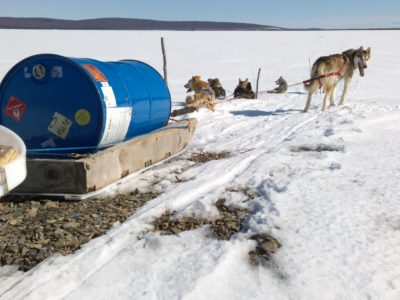
Partnerships with Local Communities Facilitate Knowledge Exchange
Partnerships with Local Communities Facilitate Knowledge Exchange
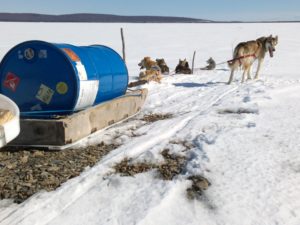
Climate-related changes in environmental conditions are challenging rural residents’ ability to traverse the land and access subsistence resources.
Credit: Miki Collins
Local residents observe that warming has changed the timing of freeze up, affected river ice thickness and melt, and has reduced winter travel safety and access to local ecosystem services. Wildfire reduces access to the land, threatens cultural and historic sites, and reduces wildlife densities for one to several decades (e.g. moose and caribou, respectively). Sources of resilience range from oral traditions and cooperative harvesting strategies to new technologies and network sharing.
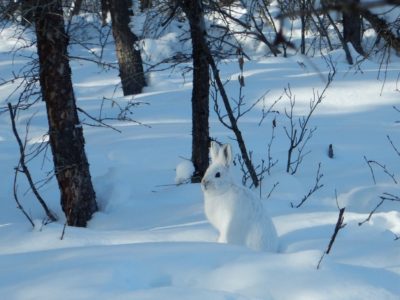
Browsing by Large Herbivores Influenced Ecosystem Function
Browsing by Large Herbivores Influenced Ecosystem Function

Browsing by snowshoe hares and moose have dramatic top-down influences on vegetation composition, successional dynamics, and ecosystem function throughout interior Alaska.
Credit: Knut Kielland
Browsing by moose and snowshoe hares affects plant species composition, growth, population dynamics, nutrient cycling, and ecosystem function at both stand and landscape scales, causing effects that can persist for decades. Both species selectively consume willows, leading to the dominance of alder, an important nitrogen-fixing species that is chemically defended against herbivory. Snowshoe hare abundance varies nearly as much on an intra-annual basis as it does across a decadal population cycle, underscoring the complex interaction of biophysical factors. This in turn influences predation intensity and the population abundance of lynx, which is largely controlled by emigration and immigration.

A Longer Snow Free Season is Likely to Speed Up Warming
A Longer Snow Free Season is Likely to Speed Up Warming
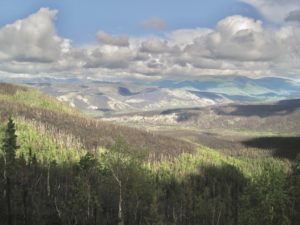
Recent models indicate that lengthening of the snow-free season and associated declines in surface albedo constitutes the largest positive feedback to climate warming in the boreal forest.
Credit: Roger Ruess
Models that assess climate feedbacks over the next century have simulated decreases in albedo due to a shorter snow season, wider extents of deciduous forest due to altered fire regimes, and changes in climate and atmospheric CO2 and CH4 emissions. The strongest climate feedback was positive, derived from lengthening the growing season (reducing the snow-albedo feedback). Increases in young, faster-growing deciduous forests and a net increase in carbon uptake by terrestrial ecosystems only partially counterbalanced this change.










